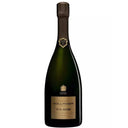Personal advice
Bollinger La Grande Année 2008 and R.D. 2008 are two exceptionally good champagnes that make our hearts as champagne lovers beat faster. Both are made from the same blend of 71% Pinot Noir and the rest Chardonnay. Due to its four-year longer yeast aging, the R.D. 2008 is in a good drinking window for the coming years. After that, it will close down and reach its true maturing phase. Perfectly stored bottles will develop positively for many decades.
Should you buy R.D. 2008? Alfavin gives you many details here to help you make the right choice.
Both R.D. and La Grande Année are based on the same base wines from the grapes of Bollinger's best vineyards. However, R.D. stays on the lees three to six years longer. It is released to the market when it is already in a good drinking window. La Grande Année 2008 is still closed and acidic. This was also the case with Bollinger's Vintage Champagnes, the predecessors of Grande Année.
Lily Bollinger decided to leave the 1952 vintage on the lees for a longer period. She released it in 1967 as R.D. – récemment dégorgé – to the market. The bottle fermentation only takes a few weeks and the yeast has done its job. In autolysis and the Maillard reaction, the yeast then develops more and more complex flavors over the years. Yeasty pastry notes appear quite quickly. Over time, roasted notes that remind of coffee come through. Earthy aromas, which can remind of truffles, also develop.
With R.D. 2008 extra brut, the bubbles are very fine, but they remain more present due to the lees aging compared to the already disgorged bottles of La Grande Année. R.D. 2008 is already more aromatic at launch than La Grande Année. The acidity is better integrated, while La Grande Année 2008 still shows untamed power.
R.D. 2008 is already in a good drinking window. By 2027, it will likely close a bit, so the fruit will no longer be as prominent. In some vintages, this effect is not as strong. The 2004 vintage also closed down, but it was still enjoyable to drink. The effect is stronger in concentrated vintages with high acidity.
In the years after, more interesting aromas will develop. Nutty, chocolaty notes will come through stronger than the yeast and toasting. The fruit will change to dried apricots, citrus notes, and orange peel.
In principle, you can drink R.D. earlier than La Grande Année. However, in the vintages 2012, 2014, and 2015, Grande Année is also wonderful to drink after disgorgement, especially if it’s aerated. Often, 24 hours is optimal.
R.D. 2008 is structured for eternity. It will take ten, fifteen years to reach its peak, at which point it will last for decades.
The growing conditions in 1988 were similar to those in 2008. Perfect bottles of R.D. 1988 are still improving.
Doesn't R.D. play in a different league, both in terms of price and quality? This cannot be answered definitively. There are vintages where it clearly surpasses La Grande Année.
In other vintages, La Grande Année, with its power and intensity, is hard to beat, and R.D. offers a more subtle, elegant version that unfolds its complexity over hours.
For the 2008 vintage, R.D. will offer significantly more enjoyment than Grande Année in the coming years. After that, R.D. will be a silkier, more elegant version, while Grande Année will express its power more directly. Over time, the aromas will start to resemble each other.
The base wines for R.D. and La Grande Année 2008 consist of 71% Pinot Noir and 29% Chardonnay. A large portion of the Pinot Noir comes from the Grands Crus Ay and Verzenay,
Ay, with Mareuil and Cumières, has the warmest sites in Champagne, famous for their rich Pinot Noirs. Long before the first Champagnes were made, the red wines of Ay were the most famous in France, even before Burgundy. The deep, fine-grained chalk soils give the wines not only body but also structure and finesse.
Not far away lies another Grand Cru, which is very important for Bollinger: Louvois. This site is also known for its full-bodied Pinot Noirs. However, the vineyards are not as steeply oriented towards the south, and the Marne does not shield the vineyards from the cold as a heat buffer.
The neighboring village Tauxières is a Premier Cru, which produces somewhat lighter but very fine wines. These are another important component of Bollinger's great cuvées.
Verzenay is a cooler Grand Cru site that delivers transparent, precise, salty, and mineral Pinots. Avenay Val d'Or and Verzy also contribute red grapes.
Chardonnays from the famous sites Le Mesnil sur Oger and Cramant provide a large portion of the white grapes. But also lesser-known sites like Grauves, known for its intense, racy acidity, and Cuis, contribute.
The Champagne RD 2008 extra brut is already an experience. Intense roasted nuts, almonds, honey, mirabelle, apricot, gingerbread, and a salty minerality are the first impressions. With a bit of air, the fruit of vineyard peaches, lemon, and orange peel emerge on the palate, complementing the nutty and toasty aromas. RD 2008 already leaves a deep sense of satisfaction, but of course, it’s worth waiting.
Experience with similar vintages teaches us that the distinct acidity and yeasty perlage will perfectly integrate into the silky palate in the coming years, and the aromas, reminiscent of nougat, gianduja, dried apricots, and roasted coffee, will become even more expressive.
Read community tasting notes of RD 2008 on cellar tracker:https://www.cellartracker.com/RD2008
https://www.cellartracker.com/RD2008
![]()
